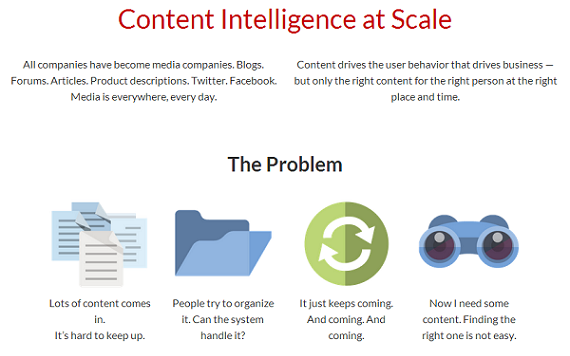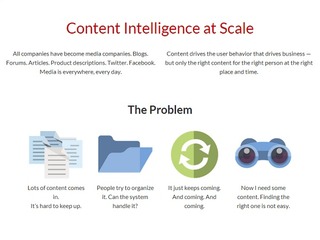

Temnos, a PaaS company that focuses on content intelligence for media companies, has now officially come out of stealth mode with $1.25 million in seed funding, it was announced Thursday. The funding came from unnamed angel investors.
The new funding will be used the funds to continue to expand the platform, as well as hire key engineering and sales staff.
“It will largely be used for business development. We are adding three additional members to the business development team, on both the east and west coasts,” Tim Musgrove, founder and executive chairman at Temnos, told me in an interview.
“We are also going to add a little to tech team, but we plan to stay small. We will only have a dozen employees for next 12 months. We don’t need more than that.”
In addition to the funding news, the company also announced the addition of its new CEO: Jim Bailey, the former CEO of Exis. Under Bailey’s leadership, Exis reached more than $1 billion in annual sales.
Temnos is an intelligence platform that helps content creators maximize user engagement by analyzing, organizing, tagging and filtering their content. While there are a number of other services that use keyword search to help drive targeted advertising, including Peer39, those other companies do not go as deep as Temnos, Musgrove told me.
Temnos uses an algorithm that is able to find more keyword targets to better show advertisers what content would work best for them. And it products for its clients such as summarizations, alternative headlines, the reading level of the document, tags and topics.
Here’s an example of how it works:
Federated Media Publishing, which houses a network of thousands of publishers, uses the Temnos platform for contextual targeting.
That means that if Federated Media wants to find articles that will appeal to brands looking to advertise on stories that have to do with small businesses, Temnos will search those articles for keywords and phrases that indicate that they are about that topic.
But Temno goes beyond simply looking for the term “small business,” since that might be just a tiny fraction of the potential inventory. Tenmos’ algorithm instead is able to discover hundreds of related topics, such as “QuickBooks,” “SBA loans,” or “Schedule C.” QuickBooks is a software tool used by small businesses, while Schedule C is a tax form that only small businesses would fill out.
Temnos also gives out a percentage score for each article, helping advertisers to know if that article, even if it does contain some keywords, is worth spending money on.
For example, an article about football might contain some baseball related phrases. The football keywords, like NFL, Raiders, Chargers, etc, would come up more often than phrases such as MLB, A’s, Padres, etc. So, even though that article may contain baseball-related keywords, the advertiser would know that running a baseball themed ad on that page would probably not get as many clicks as one that was aimed at football fans.
Temnos helps publishers save money by using filtering through large amounts of data, which would take considerable manpower and time. And helps publishers make money by increasing click through rates on their advertisements.
The history of Temnos
Musgrove is the former CEO of TextDigger, a semantic search company that was purchased by Federated Media in 2010. The company was able to remain as a standalone company within Federated Media.
“At Federated Media, there were three or four different teams doing different projects in different locations, and they all wanted to use TextDigger,” Musgrove said. “We became a PaaS company inside of Federal Media and had to create an API, which became the company that Temnos is now.”
And then the timing became right for Temnos to spin out of Federated Media.
“Back in 2008 and 2009, ad networks weren’t mature yet, and the platform as a service model hadn’t taken hold,” said Musgrove “Now, everyone is using PaaS. It is much better than it was just a few years ago.”
The San Jose-based company was founded in January of this year and it has 12 customers so far, six of which are currently paying, while the other six are still in a two month “beta period” where they are allowed to try out the service for free.
The company makes money via a volume based subscription model. Companies pay based on the types of services they want, and the number of URLs.















